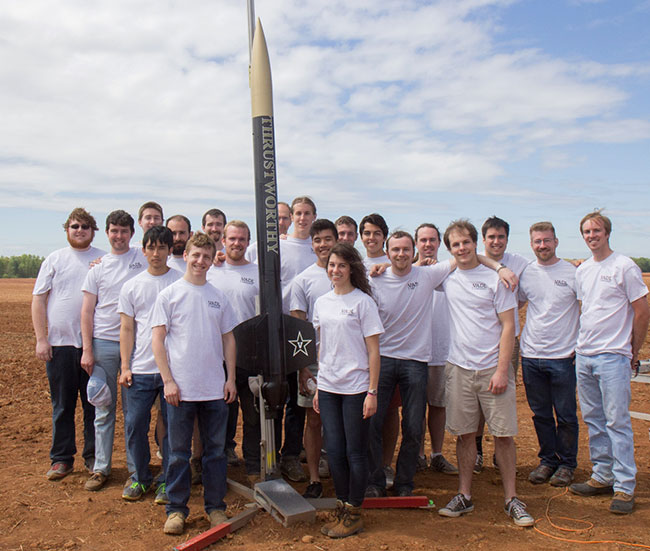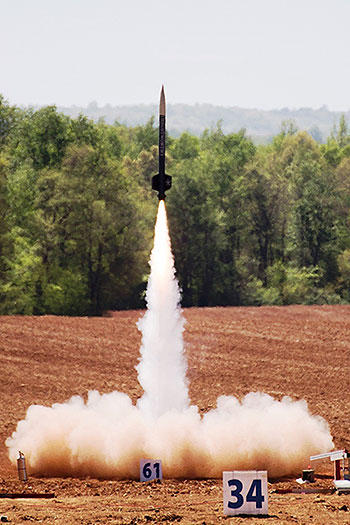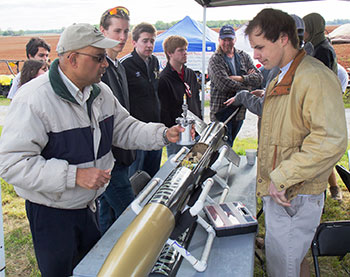
The Vanderbilt student rocket team collected two key awards in NASA’s Student Launch Challenge following a near flawless flight of their Thrustworthy rocket Saturday, April 16, at Bragg Farms in Toney, Alabama.
At the awards banquet held at the U.S. Space and Rocket Center in Huntsville, Vanderbilt – three-time national champs – won the coveted payload design and project review awards, setting up a strong challenge to win the overall championship, according to faculty adviser Amrutur Anilkumar, professor of mechanical engineering. This is the sixth payload design award the team has won during its last nine entries in the NASA university rocketry competition.

Teams will submit flight reports April 29 and after a detailed review of flight data, NASA will announce final overall results May 11. Forty of the nearly 50 rocket launch teams from 22 states were university students, including teams from Cornell, Georgia Tech, Northwestern, Louisville, Notre Dame, Penn State, Illinois and Florida, competing for awards and a $5,000 cash prize.
“Our rocket Thrustworthy is aptly named. By the time we were ready to launch, the winds had calmed down, the rocket took off beautifully, reached apogee and the parachutes deployed as planned. The rocket landed safely for a successful launch,” said senior Andrew Voss, team president and chief designer of the carbon fiber rocket airframe. Voss has been a member of the past three national championship teams and, along with team members Quinlan Monk and Robb Rutherford, he will work at Space-X following graduation.
Supported by the Human Exploration and Operations Mission Directorate and U.S. aerospace industry, NASA Student Launch is a NASA-conducted engineering design challenge built around a NASA mission. It is an eight-month commitment to design, build, and fly payloads that support Space Launch System (SLS). Research and investigation topics are conceived by the SLS Program Office in collaboration with SLS industry partners. The process is intended to mirror the NASA engineering lifecycle, with design reviews, a flight-readiness review, and a launch-readiness review that includes a safety briefing.
This year, the Vanderbilt team designed a green monopropellant thruster using 70 percent hydrogen peroxide as the fuel, specifically for low-altitude rocket flight and validated it through ground based and flight testing. NASA cited Vanderbilt for its very creative and innovative design, while maximizing safety and scientific value.
“The biggest challenge to testing a liquid-fueled engine in low-altitude rocket flight is fuel delivery. When the solid motor cuts off, there is rapid deceleration on the craft, and the liquid in the tank will rapidly slosh to the roof. It is essential to abate the slosh so fuel is available at the pickup. Fluid containment at solid motor cutoff requires a great deal of ingenuity,” said Rutherford, who designed the slosh abatement system for the fuel tank.

“The team built everything from scratch, including the ground testing facility and the thruster, which was ratified for both pulsed and continuous operation. NASA was particularly impressed by the details the team presented and the depth of knowledge and project experience each of the team members brought to the design reviews,” said Anilkumar.
Design reviews carry 45 percent weight in NASA scoring and the launch Saturday carries a 30 percent weight. Outreach efforts count 10 percent, a team’s website is 5 percent, with the final report an additional 10 percent.
“Ours is an eight-month boot camp in aerospace engineering where the students, both graduate and undergraduate, are challenged to take up a flight-based energy conversion challenge, and take it toward design, fabrication, testing and flight validation, all the while being aware that failure is not an option, Anilkumar said.”
NASA and the National Association of Rocketry requested the team to use an inert fluid while firing the thruster at the public launch on Saturday. “On flight day, we switched the fuel with soap solution and modified the exit nozzle to blow a swarm of tiny bubbles that left a blue bubble cloud in the exhaust at takeoff,” said graduate student Chris Lyne, who led the team effort in designing the monopropellant thruster.
“Our thruster analysis, design and testing protocols were so perfect that the thruster worked on first try in ground-based testing, and was ready for flight integration. As hydrogen peroxide is very reactive, NASA put us through a very intense protocol for materials selection and safety operating procedures that we incorporated into ground based tests,” said Quinlan Monk, the materials expert on the team.
“We are looking forward to analyzing our launch data, conduct a detailed post flight structural analysis of the rocket and present the final results to NASA pretty soon,” said structural engineer Andrew Martin who will be working for Aerospace and Defense Manufacturer TE Connectivity.
“Launch day is particularly stressful looking at failures of some of the teams; it is hard to bear these setbacks considering all the hard work that would have gone into the designs. I am really happy that everything went off well,” said Mitchell Masia, a computer engineering major and vice president of the student launch team. Masia designed the Vanderbilt Aerospace Design Lab website and was part of the avionics team.
“A successful launch requires a very methodical run through the launch check list, which has several hundred items and procedures that the team needs to tick off before the launch can be green lighted,” said Justin Broughton, who was the team’s launch manager. He is heading to Georgia Tech for graduate study in aerospace engineering.
While the worst of Masia’s imagined scenarios did not materialize, the team was surprised by the rocket’s altitude: 5,552 feet, against a predicted altitude of 5,000 feet. The NASA competition includes a contest to launch to an altitude of one mile, or 5,280 feet, above ground level. Above or below that altitude costs teams points.
“We will look into a variety of scenarios: lower friction from the shorter NAR launch rails we used, presence of low winds just at launch, higher atmospheric temperatures, along with a slightly lower launch mass at takeoff, and provide a detailed report to NASA,” said flight dynamist Dylan Shane, who is entering the University of Texas Austin for a Ph.D. in aerospace engineering.
“In particular, the Structural Health Monitoring Sensor data should help unravel the mystery of the launch rail,” said David Hirsch, who is planning graduate study in aerospace engineering at University of Illinois at Urbana-Champaign.
Apart from serious non-stop engineering, the team also is passionate about science outreach to area schools.
“This year we reached about 1,700 middle and high school students in middle Tennessee through novel teaching tools we developed to teach aerospace engineering. It was extremely gratifying to see our science students from Page High School in Franklin, Tennessee, make the trip to see our launch Saturday. In fact, we delayed our launch until the students showed up at the site,” said outreach coordinator and computer engineering student Rebecca Riley, who also was a payload electronics designer on the team.
Robin Midgett, electronics technician in the mechanical engineering department is the team’s rocketry mentor, and Brian Lawson, post graduate researcher in mechanical engineering, is the dynamics mentor and Professor Heather Johnson in the Peabody School is the outreach advisor for the team.
The Vanderbilt student launch activities are sponsored by the Department of Mechanical Engineering and the Boeing Corporation.
Contact:
Brenda Ellis, (615) 343-6314
Brenda.Ellis@Vanderbilt.edu
Twitter @VUEngineering